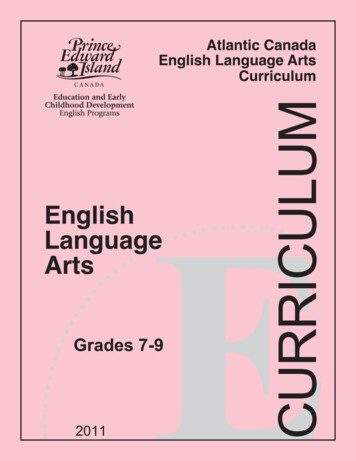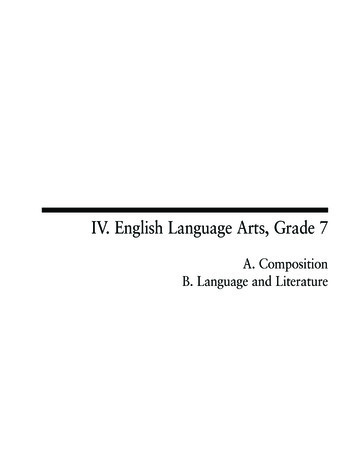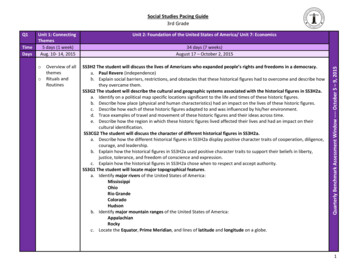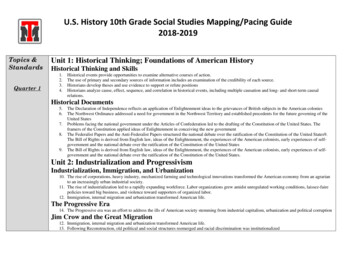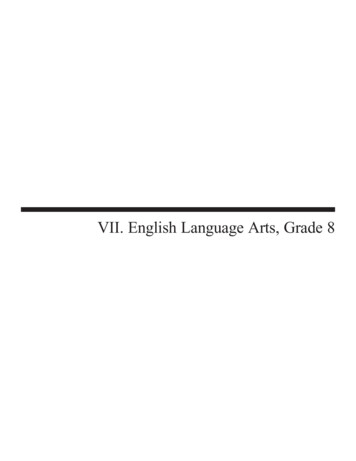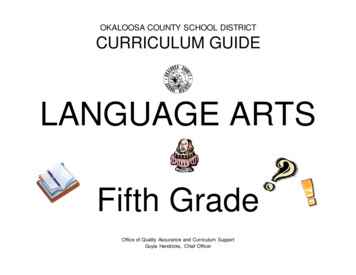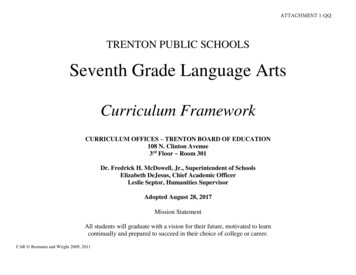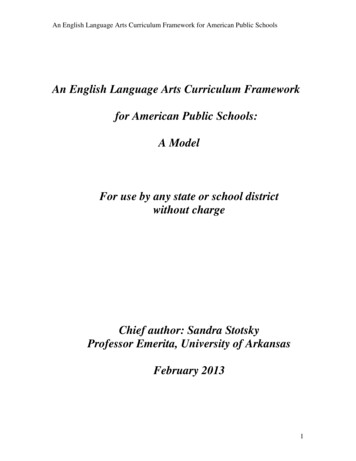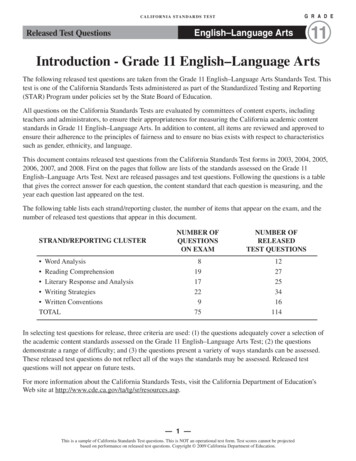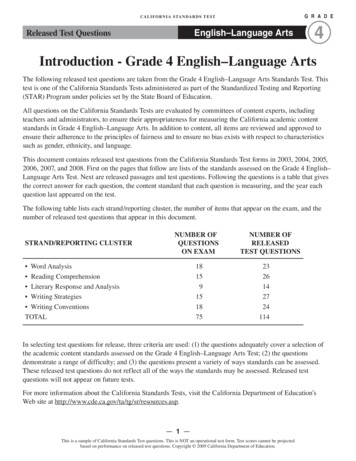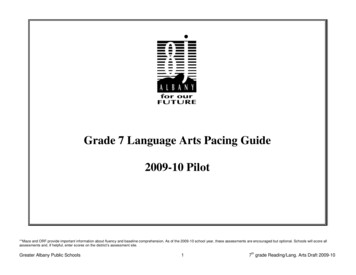
Transcription
----- ------ -- -- - -- -for ourFUTUREGrade 7 Language Arts Pacing Guide2009-10 Pilot**Maze and ORF provide important information about fluency and baseline comprehension. As of the 2009-10 school year, these assessments are encouraged but optional. Schools will score allassessments and, if helpful, enter scores on the district’s assessment site.Greater Albany Public Schools1th7 grade Reading/Lang. Arts Draft 2009-10
----- ------ -- -- - -- -for ourFUTUREGrade 7 Reading2009-10 Pilot**Maze and ORF provide important information about fluency and baseline comprehension. As of the 2009-10 school year, these assessments are encouraged but optional. Schools will score allassessments and, if helpful, enter scores on the district’s assessment site.Greater Albany Public Schools2th7 grade Reading/Lang. Arts Draft 2009-10
Grade Level: 7thReading: Read and understand grade-level informational and literary text.Beginning with the graduating class of 2012, each student is required to demonstrate Essential Skill in Reading in order to earn a diploma. This can be done by either of the following methods duringhigh school: 1) Earn a 236 on the OAKS reading assessment or 2) Score a 4 in each required trait on the reading scoring guide after completing an “on grade-level” reading work sample. In order toprepare middle school students to meet this diploma requirement, teachers are encouraged to create, assign, and score reading work samples, as well as help each student make optimum growth asa reader.WhenSem. 1Learning Concept7.1.1 Decoding and WordRecognition-Analyze words, recognizewords, and learn to read grade-leveltext fluently.Word Recognition 7.1.1.1 Identify and use affixes, rootwords, marked words.Word Analysis 7.1.1.2 Use context clues. 7.1.1.3 Decode unfamiliar words.Sem. 1Fluency 7.1.1.4 Read orally with accuracy,pacing, intonation, and expression. 7.1.1.5 Read independently.7.1.2 Read Informational andLiterary Texts-Demonstrate generalunderstanding of informational andliterary text.Comprehension of Information andLiterary Texts 7.1.2.1 Identify fact, opinion, mainidea, supporting details, sequenceof events. 7.1.2.2 Summarize main idea,supporting details, and sequence ofevents. 7.1.2.3 Understand a wide varietyVocabulary orKey Termsaccuracyautomaticitycontext rts of speechprefixroot wordsuffixCore ProgramLocationWord RecognitionHolt Elements of Lit. 7 pp. 163, 270, 650-653,663, 809, 815, 819, 832 Rewardsp. 80autobiographybiographycomparecomprehension strategycontent areacontrastcorrection strategiesdiagramfictionfirst-person point of viewgraphic organizersinformational textliterary textmain ideaComprehension ofInformational TextsHolt Elements of Lit 7 p. 882 Features of Info. Textpp. 32, 52, 81 Main Idea pp. 187, 480,739 Fact & Opinion pp.672 Strategies/ GraphicOrganizers pp. 381,415Supplement with outsideWord AnalysisHolt Elements of Lit. 7 pp. 289, 295, 695AssessmentInterventions Read 180 Rewards 6 Minute SolutionCoreStandardODE ContentStandards:EL.07.RE.01Word Analysis**MazeFluency6 Minute Solution pp. 12-13**ORF See below forimportant districtassessment informationInterventions Read 180 Read for Real JamestownSignature Readers Holt Reader Holt Adapted ReaderODE .LI.01-03Holt Elements of Lit. 7 Reading Tests pp. 923926 Skills Review pp. 118121**Maze and ORF provide important information about fluency and baseline comprehension. As of the 2009-10 school year, these assessments are encouraged but optional. Schools will score allassessments and, if helpful, enter scores on the district’s assessment site.Greater Albany Public Schools3th7 grade Reading/Lang. Arts Draft 2009-10
WhenLearning Concept of texts (classic and contemporaryliterature, historically or culturallysignificant words of literature,poetry, magazines, newspapers,reference materials, onlineinformation, and content areatexts).7.1.2.4 Match reading to purpose.7.1.2.5 Create outlines, graphicorganizers, diagrams, notes,summaries.7.1.2.6 Identify and use correctionstrategies.7.1.2.7 Apply comprehensionstrategies to match form: fiction,poetry, nonfiction, textbook,newspaper, diagram, chart, maps.7.1.2.8 Clearly identify specificwords or wordings that are causingcomprehension difficulties and usestrategies to correct.7.1.2.9 Demonstrate listeningcomprehension of more complextext through class and/or smallgroup interpretive discussion acrosssubjects.Connections to informational andLiterary Texts 7.1.2.10 Relate text to self, text,and world. 7.1.2.11 Compare and contrast textto self, text, and world. 7.1.2.12 Respond to historic orcultural works of literature.Vocabulary orKey Termsmake connectionsnarratornonfictionomniscient point-of-viewopinionsoutline point-of-viewrelatesequencesummarysupporting detailthird-person point-of-viewCore ProgramLocationresources for the following: Sequence Fact & Opinion Correction StrategiesAssessmentCoreStandardComprehension ofLiterary TextsHolt Elements of Lit. 7 p. 882 Plot pp. 2, 14, 57, TE917B, D Main Idea pp. 393, 480 Summarizing pp. 4,14, 644, 688, 698, 732 Fact & Opinion pp.402, 499 Sequence TE p. 917DSupplement with outsideresources for the following: Sequence Correction StrategiesConnections toInformational TextsHolt Elements of Lit. 7 Compare andContrast pp. 164, 496Connections to LiteraryTextsHolt Elements of Lit. 7 Compare andContrast pp. 84, 190,296, 428, 484, 746, 845*Comprehension includes listening toand reading a variety of texts.**Maze and ORF provide important information about fluency and baseline comprehension. As of the 2009-10 school year, these assessments are encouraged but optional. Schools will score allassessments and, if helpful, enter scores on the district’s assessment site.Greater Albany Public Schools4th7 grade Reading/Lang. Arts Draft 2009-10
WhenSem. 1Learning Concept7.1.3 Vocabulary-Increase wordknowledge through systematicvocabulary development.Vocabulary Acquisition 7.1.3.1 Increase exposure to newwords. 7.1.3.2 Determine meaning ofunknown words using contextualand structural clues. 7.1.3.3 Adopt new words. 7.1.3.4 Use knowledge of Greek,Latin, and Anglo-Saxon roots andword parts to understand subjectarea vocabulary. 7.1.3.5 Clarify word meaningsthrough the use of definition,inference, example, restatement, orcontrast.Figurative Language 7.1.3.6 Interpret idioms, similes,analogies, metaphors,personification, hyperbole,symbolism, imagery, and wordswith multiple meanings in prose andpoetry. 7.1.3.7 Recognize rhythm, meter,rhyme, repetition, line length.Vocabulary orKey figurative languagehyperboleidiomsimageryinferenceline hymerhythmroot wordsimilestanzasymbolismword partCore ProgramLocationVocabularyHolt Elements of Lit. 7 Roots & Word Partspp. 145, 173, 270, 663,681, 687, 809, 815,819, 843 Clarify WordMeanings pp. 31, 51,69, 80, 186, 363, 400,409, 427, 495, 506,525, 671, 706, 717,745, 832 Comparison pp. 265,288, 532, 541Figurative LanguageHolt Elements of Lit. 7 pp. 546-547, 609, 612,619, 671 Similies andMetaphors pp. 255,608-609, 626 Analogies pp. 265,288, 532 Hyperbole (text refersto hyperbole asexaggeration – makesure students know theterm hyperbole) pp.578, 585 Symbolism pp. 585,588 Imagery pp. 527 546,563, 593, 597, 619, 622 Idiom (text refers toAssessmentVocabularyHolt Elements of Lit. 7 pp. 640 Skill Review pp. 122,230, 342, 472, 640, 780,874CoreStandardODE ve LanguageHolt Elements of Lit. 7 pp. 638-639 Skills Review pp. 336339, 638-639Poetic DevicesHolt Elements of Lit. 7**Maze and ORF provide important information about fluency and baseline comprehension. As of the 2009-10 school year, these assessments are encouraged but optional. Schools will score allassessments and, if helpful, enter scores on the district’s assessment site.Greater Albany Public Schools5th7 grade Reading/Lang. Arts Draft 2009-10
WhenSem. 1Learning Concept7.1.4 Read to Perform a Task: Find,understand, and use specificinformation in a variety of texts toperform a task. 7.1.4.1 Read informational texts:Sem. 2textbooks, biographical sketches,letters, diaries, directions,procedures, magazines, essays,primary source historicaldocuments, editorials, news stories,periodicals, bus routes, catalogues,technical directions: consumer,workplace, and public documents. 7.1.4.2 Locate information in titles,table of contents, chapter headings,illustrations, captions, glossaries,indexes, graphs, charts, diagrams,and tables. 7.1.4.3 Locate information by usingconsumer product information. 7.1.4.4 Explain the use of a simplemechanical device by followingtechnical directions.7.1.5 Develop an Interpretation:Develop an interpretation of grade-levelinformational and literary text. 7.1.5.1 Predict future outcomessupported by literary andinformational texts. 7.1.5.2 Make inferences fromliterary and informational texts andsupport with text-based examples.Vocabulary orKey Termsbiographical sketchcaptioncatalogueconsumer productinformation editorialsglossaryheadinghistorical documentsillustrationindexmechanical devicenews storiesperiodicalsprimary sourceroutesschedulesstructural featuretable of contentsanalyzecharacter traitscharacterizationdialoguedraw ncemain ideaCore ProgramLocationidiom as figure ofspeech – make surestudents know the termidiom) pp. 283, 546,548, 609Holt Elements of Lit 7 pp. 32, 52, 81-83, 879908Lessons needed aroundexamples of: Informational Text pp.32, 165, 257, 267, 285,351, 365, 390, 411,497, 789, 817, 872 Magazine Articles pp.340, 470, 689, 883 Newspaper Articlespp. 53, 188, 544Holt Elements of Lit. 7 Predictions pp. 38,174, 356, 368, 707 Make Inferences pp.57, 136, 146, 168, 393,718 Author’s Point of Viewpp. 168, 348-350, 364,393, 410, 414First-Person pp. 348,AssessmentCoreStandardHolt Elements of Lit. 7 See TE p. 878DAssessment column formultiple assessmentoptions in supplementalmaterials Skills Review pp. 123ODE ContentStandards:EL.07.RE.14-17Holt Elements of Lit. 7 Author’s Point of ViewSkills Review pp. 468469ODE e and ORF provide important information about fluency and baseline comprehension. As of the 2009-10 school year, these assessments are encouraged but optional. Schools will score allassessments and, if helpful, enter scores on the district’s assessment site.Greater Albany Public Schools6th7 grade Reading/Lang. Arts Draft 2009-10
WhenLearning Concept 7.1.5.3 Infer the main idea ofliterary and informational when it isnot explicitly stated, and supportwith text-based examples. 7.1.5.4 Identify and trace thedevelopment of an author’sargument, point of view, orperspective in a specific textthrough a graphic organizer or asummary.Sem. 2Literary Texts Only 7.1.5.5 Identify and evaluatethemes. 7.1.5.6 Identify events that advancethe plot, and determine how eachevent explains past or presentaction(s) or foreshadows futureaction(s). 7.1.5.7 Analyze characterization asrevealed through a character, thenarrator, and other characters. 7.1.5.8 Infer unstated reasons foractions based on events andimages from the text.7.1.6 Examine Content andStructure: Examine content andstructure of grade-level informationaland literary text. 7.1.6.1 Determine author’s purposeand how the author’s perspectiveinfluences the text. 7.1.6.2 Differentiate betweenconclusions based on fact andthose based on opinion. 7.1.6.3 Analyze text to determinethe type and purpose of theorganizational structure being usedVocabulary orKey ficancesummarytext-based examplesthemeanalysisauthor’s purposeautobiographybackground aracterizationcompare and onCore ProgramLocation368Third-Person p. 348Omniscient pp. 348,356, 382AssessmentLiterary Texts OnlyHolt Elements of Lit. 7 pp. 244-246, Collection3 focuses on theme &characterization Theme pp. 236-238,244-246, 296, 428, 787 Characterization pp.128-130, 136, 146, 174,190, 196, 204-205Literary Texts OnlyHolt Elements of Lit. 7 Skills Review pp. 228229Holt Elements of Lit. 7 Make Inferences pp.57, 136, 146, 168, 393,718 Fact & Opinion pp.402, 408, 499, 505 Author’s Perspectivepp. 78, 393, 816 Compare & Contrastpp. 84, 190, 296, 428,746, 845 Text Structure pp. 32,83, 121, 496, 831, 879908Holt Elements of Lit. 7 Author’s PerspectiveSkills Review pp. 470471, 872-873CoreStandardODE e and ORF provide important information about fluency and baseline comprehension. As of the 2009-10 school year, these assessments are encouraged but optional. Schools will score allassessments and, if helpful, enter scores on the district’s assessment site.Greater Albany Public Schools7th7 grade Reading/Lang. Arts Draft 2009-10
WhenLearning ConceptVocabulary orKey Termsby the author on, prioritization,comparison/contrast, or cause-andeffect). 7.1.6.4 Compare and contrastinformation on the same topic afterreading several passages orarticles. 7.1.6.5 Analyze the difference instructure and purpose betweenvarious categories of informationaltext (textbooks, newspapers,instructional manuals, essays,editorials, biographies, andautobiographies).factfictionfigurative languagefirst-person point-of-viewhumorimageryinstructional manualline lengthliterary devicesliterary elementsliterary formsliterary techniqueslogicmake connectionsmetaphornonfictionopinionorganizational pattern ingstanza and line structuresuspensesymbolismthemetoneword choiceLiterary Texts Only 7.1.6.6 Differentiate effects ofcommon literary devices(symbolism, imagery, metaphor) invariety of literary texts. 7.1.6.7 Evaluate how well literaryelements contribute to the overalleffectiveness. 7.1.6.8 Identify and analyzethemes. 7.1.6.9 Differentiate among anddiscuss the purposes andcharacteristics of different forms ofprose (short story, novel, andessay).Core ProgramLocationSupplement with outsideresources for the following: author’s perspective text structure analysisLiterary Texts OnlyHolt Elements of Lit. 7 Collection 7 focuses onliterary criticism Literary DeviceEffects pp. 786-787 Evaluating Theme pp.237, 787 Prose pp. 478-479,484, 508, 533Supplement with outsideresources for the following: Evaluating themeAssessmentCoreStandardLiterary Texts OnlyHolt Elements of Lit. 7 See TE p. 784DAssessment column formultiple assessmentoptions in supplementalmaterials Skills Review pp. 336339 Prose pp. 636-637**Maze and ORF provide important information about fluency and baseline comprehension. As of the 2009-10 school year, these assessments are encouraged but optional. Schools will score allassessments and, if helpful, enter scores on the district’s assessment site.Greater Albany Public Schools8th7 grade Reading/Lang. Arts Draft 2009-10
----- ------ -- -- - -- -for ourFUTUREGrade 7 Writing2009-10 Pilot**Maze and ORF provide important information about fluency and baseline comprehension. As of the 2009-10 school year, these assessments are encouraged but optional. Schools will score allassessments and, if helpful, enter scores on the district’s assessment site.Greater Albany Public Schools9th7 grade Reading/Lang. Arts Draft 2009-10
Grade Level: 7thWriting: Develop and apply grade-level writing skills. Communicate through writing.Beginning with the graduating class of 2012, each student is required to demonstrate Essential Skill in Writing in order to earn a diploma. This can be done by eith er of the following methods duringhigh school: 1) Earn a 40 composite score on the OAKS writing assessment or 2) Earn a 4 in each required trait on 3 classroom work samples (1 expository, 1 persuasive, and 1 narrative). In order toprepare middle school students to meet this diploma requirement, teachers are expected to create, assign, and score writing work samples in each of these areas. One (1) “best work” writing samplethththmust be collected, scored, and maintained in 6 , 7 , and 8 grade.WhenSem. 1Learning Concept7.2.1 Use Writing Process: Pre-write, draft,revise, edit, and publish. 7.2.1.1 Use a variety of strategies to plan forwriting. 7.2.1.2 Discuss ideas for writing with others. 7.2.1.3 Develop drafts alone andcollaboratively. 7.2.1.4 Identify audience and purpose. 7.2.1.5 Choose the form of writing that bestsuits the intended purpose. 7.2.1.6 Use the writing process. 7.2.1.7 Focus on a central idea. 7.2.1.8 Use state scoring guide to review,evaluate, and revise. 7.2.1.9 Proofread and edit alone andcollaboratively. 7.2.1.10 Revise drafts to improveorganization and word choice.Vocabulary or Key Termsaudiencebrainstormingcentral/main ideaconsistencycollaborative editingconventionsdrafteditediting checklistevaluategraphic organizersgroupingletter to the editormaking ingpersonal letterpoempre-writeproofreadpublishpurposerelevant detailsreportreviewrevisesuccessive versionsword choiceCore ProgramLocationWrite Source 7 pp. 1-69 http://thewritesource.coAssessmentm/models.htm#ws 2000CoreStandardODE ContentStandards:EL.07.WR.01-09Graphic Organizers forwriting:Write Source 7 pp. 801-805**Maze and ORF provide important information about fluency and baseline comprehension. As of the 2009-10 school year, these assessments are encouraged but optional. Schools will score allassessments and, if helpful, enter scores on the district’s assessment site.Greater Albany Public Schools10th7 grade Reading/Lang. Arts Draft 2009-10
writing processSem. 17.2.2 Develop Writing: Write multi-paragraphcomposition applying the six traits of writing.Ideas and Content 7.2.2.1 State thesis or purpose. 7.2.2.2 Use relevant evidence. 7.2.2.3 Support all statements withanecdotes, descriptions, facts, and statisticsand/or specific examples.Organization 7.2.2.4 Indents for paragraph breaks. 7.2.2.5 Use clear organizational pattern andsequencing. 7.2.2.6 Includes introduction, body, andconclusion. 7.2.2.7 Use effective transitions. 7.2.2.8 Make paragraph breaks when usingdialogue.Voice 7.2.2.9 Write for different purposes and to aspecific audience. 7.2.2.10 Engage audience. 7.2.2.11 Use active voice rather than passivevoice.Word Choice 7.2.2.12 Use a variety of precise descriptivewords. 7.2.2.13 Properly place modifiers (words orphrases that describe, limit, or qualifyanother word).Sentence Fluency 7.2.2.14 Use variation in sentence structures. 7.2.2.15 Use infinitives and participles tovary sentence structure. 7.2.2.16 Control over simple and compoundactive logueevidencefactflowideas and ational patternparticiplepassive voiceprecise word choicepurpose/main idearelevantrhythmsentence fluencyspecific examplestatisticstylesupporting detailthesistonetransitionvoiceIdeas and ContentWrite Source 7pp. 544-548 Oregon StateScoring Guide Oregon State StudentScoring Guide 1 work samplerequiredOrganizationWrite Source 7pp. 550-555Write Source 7 Rubrics pp. 767-775Holt Elements of Lit.7 Skills Review pp.231, 343, 473, 641,781, 875ODE ContentStandards:EL.07.WR.10-16VoiceWrite Source 7pp. 556-557Word ChoiceWrite Source 7pp. 558-567Sentence FluencyWrite Source 7pp. 270-272Holt Elements of Lit. 7**Maze and ORF provide important information about fluency and baseline comprehension. As of the 2009-10 school year, these assessments are encouraged but optional. Schools will score allassessments and, if helpful, enter scores on the district’s assessment site.Greater Albany Public Schools11th7 grade Reading/Lang. Arts Draft 2009-10
sentence structures. 7.2.2.17 Use complex sentence.pp. 1000-1003, 10081012Holt Handbook 7Section 2 Ch. 18-19*Conventions covered in 7.2.3Sem. 1-27.2.3 Apply Conventions: Demonstrateknowledge of spelling, grammar,punctuation, capitalization, andpenmanship. 7.2.3.1 Spell frequently misspelled wordsand derivatives correctly. 7.2.3.2 Use pronouns and antecedentscorrectly. 7.2.3.3 Use all parts of speech correctly. 7.2.3.4 Demonstrate correct English usage. 7.2.3.5 Use a comma after a dependantclause that introduces a sentence. 7.2.3.6 Use internal punctuation, includingcommas, semicolons, and colonsappropriately. 7.2.3.7 Use exclamation and question markscorrectly with quotation marks. 7.2.3.8 Use correct capitalization. 7.2.3.9 Write ausecoloncommascompound subjectcontractionconjunctiondependant clausederivativesfuture perfecthomonymhomophoneindefinite pronouninterjectionlegiblynounpart of speechpast perfectpossessiveprepositionpresent perfectpronounquotation markssemicolonsubject-verb agreementtransitionverbHolt HandbookSection 1, Ch. 1-17ODE ContentStandards:EL.07.WR.17-25SpellingHolt Elements of Lit.7pp. 295, 706, 725, 844,1030-1033, 1039-1040Write Source 7pp. 642-687Verb TenseHolt Elements of Lit.7pp. 56, 745, 970-983Write Source 7pp.GrammarHolt Elements of Lit.7pp. 173, 283, 401, 507,526, 681, 959-969,9841012Write Source 7pp. 469-493, 702-715,718-749PunctuationHolt Elements of Lit.7pp. 1018-1029, 495, 542,362Write Source 7pp. 517, 494-498, 499516, 520-522, 582-597,518, 579-581, 598-601CapitalizationHolt Elements of Lit.7pp. 1013-1017**Maze and ORF provide important information about fluency and baseline comprehension. As of the 2009-10 school year, these assessments are encouraged but optional. Schools will score allassessments and, if helpful, enter scores on the district’s assessment site.Greater Albany Public Schools12th7 grade Reading/Lang. Arts Draft 2009-10
Write Source 7pp. 618-627Sem. 17.2.4 Demonstrate Writing Modes: Writenarrative, expository, and persuasive tests,using a variety of written forms. 7.2.4.1 Use electronic text features to locateinformation. 7.2.4.2 Use effective note-taking techniques. 7.2.4.3 Compose documents with appropriateformatting by using word-processing skills.Personal (Autobiographical) & FictionalNarrative 7.2.4.4 Develop a standard plot line,including a beginning (exposition), conflict,rising action, climax, (falling action,) andresolution. 7.2.4.5 Develop a point-of-view. 7.2.4.6 Develop complex major and minorcharacters and a definite setting. 7.2.4.7 Use a range of narrative devices, suchas dialogue; suspense; and specific narrativeaction, including movement, gestures, andexpressions.Expository 7.2.4.8 Create and follow a thesis statementto explore and explain. 7.2.4.9 Include relevant main ideas. 7.2.4.10 Support thesis and main ideas withspecific details.Literature Responseo 7.2.4.11 Demonstrate careful reading,understanding, and insight.o 7.2.4.12 Develop and organizeinterpretations, premises, or images fromthe text.accuracyautobiographical dible sourcedatabases and spreadsheetsdetailsdialoguedocumentationdraw conclusionselectronic d-opinionfictional htinterpretationinvestigationliterature responsemain ideasmajor/main characterminor charactermovementWrite Source 7pp. 441-445ODE ContentStandards:EL.07.WR.26-35Personal NarrativeHolt Elements of Lit. 7pp.112-117, 330-335Write Source 7pp. 71-82, 93-136ExpositoryHolt Elements of Lit. 7pp. 772-777, 861Write Source 7pp. 157-200Literature ResponseWrite Source 7pp. 283-317, 323-328**Maze and ORF provide important information about fluency and baseline comprehension. As of the 2009-10 school year, these assessments are encouraged but optional. Schools will score allassessments and, if helpful, enter scores on the district’s assessment site.Greater Albany Public Schools13th7 grade Reading/Lang. Arts Draft 2009-10
o7.2.4.13 Justify interpretations through theuse of text- based examples.Write Summarieso 7.2.4.14 Include main ideas and mostsignificant details.o 7.2.4.15 Reflect underlying meaning.o 7.2.4.16 Use formal paragraphstructure.o 7.2.4.17 Use the student’s own words,except for quotations.Persuasive 7.2.4.18 Create and follow a thesis statementto take a position or perspective. 7.2.4.19 Support position with wellarticulated relevant examples. 7.2.4.20 Anticipate and address counterarguments. 7.2.4.21 Differentiate fact from opinion,strong from weak arguments.Sem. 2Research Reports 7.2.4.22 Identify topics, ask and evaluatequestions, and develop ideas leading toinquiry, investigation, and research. 7.2.4.23 Use effective note-taking techniquesto ensure appropriate documentation ofquoted and paraphrased materials. 7.2.4.24 Distinguish credible sources. 7.2.4.25 Check the validity and accuracy ofinformation obtained from research. 7.2.4.26 Differentiate fact from opinion,strong from weak arguments. 7.2.4.27 Recognize that personal valuesinfluence conclusions an author draws. 7.2.4.28 Convey clear and accurateperspectives. 7.2.4.29 Create documents by using wordprocessing skills and publishing programs. 7.2.4.30 Develop simple databases andnarrative actionnote-taking techniquesparaphraseparenthetical citationspersonal narrativepersonal viewposition statement (thesis)premisepublishing programsquoterelevant questionrising actionresearch processresolutionsensory detailssettingsourcessummarysuspensetext featuretext-based examplethesis statementunderlying meaningvalidityword-processingworks cited/ bibliography pageWrite SummariesHolt Elements of Lit. 7Literary Textspp. 4, 14, 664, 668, 698,732Informational Textspp. 543, 688, 739PersuasiveHolt Elements of Lit. 7pp. 222-227, 630-635Write Source 7pp. 219-255, 261-266Research ReportsHolt Elements of Lit. 7pp. 864-869, 1041-1045Write Source 7pp. 363-415**Maze and ORF provide important information about fluency and baseline comprehension. As of the 2009-10 school year, these assessments are encouraged but optional. Schools will score allassessments and, if helpful, enter scores on the district’s assessment site.Greater Albany Public Schools14th7 grade Reading/Lang. Arts Draft 2009-10
spreadsheets to manage information andprepare reports. 7.2.4.31 Document sources. 7.2.4.32 Cite quoted and paraphrasedinformation by using a consistent format forparenthetical citations. 7.2.4.33 Use evidence compiled through theformal research process.**Maze and ORF provide important information about fluency and baseline comprehension. As of the 2009-10 school year, these assessments are encouraged but optional. Schools will score allassessments and, if helpful, enter scores on the district’s assessment site.Greater Albany Public Schools15th7 grade Reading/Lang. Arts Draft 2009-10
----- ------ -- -- - -- -for ourFUTUREGrade 7 Speaking/Listening2009-10 Pilot**Maze and ORF provide important information about fluency and baseline comprehension. As of the 2009-10 school year, these assessments are encouraged but optional. Schools will score allassessments and, if helpful, enter scores on the district’s assessment site.Greater Albany Public Schools16th7 grade Reading/Lang. Arts Draft 2009-10
Grade Level: 7thSpeaking/Listening: Communicate through speaking and effective listening.Beginning with the graduating class of 2012, each student is required to demonstrate Essential Skill in Speaking in order to earn a diploma. This MUST be done through the following method in highschool: Complete 3 speeches (1 expository, 1 persuasive, 1 unrehearsed) and score a 4 on each of the four required traits on the official state speaking scoring guide. In order to prepare middleschool students to meet this diploma requirement, teachers are expected to create, assign, and score speaking work samples. O ne (1) “best” speaking work sample must be delivered and scored inththth6 , 7 , and 8 grade.WhenSem. 1-2Learning Concept7.3.1 Speak: Communicate ideas using oral,visual, and multi-media forms. 7.3.1.1 Develop a focus and point of view. 7.3.1.2 Match the purpose, message,occasion, and delivery to the audiences’interests and background. 7.3.1.3 Organize information usingsupporting details effectively andpersuasively in relation to the audience. 7.3.1.4 Use traditional structures forconveying information, including causeand-effect, similarity and difference, andposing and answering question. 7.3.1.5 Use a variety of descriptive andaccurate words appropriate to audience andpurpose. 7.3.1.6 Use correct grammar consistently. 7.3.1.7 Use speaking techniques, includingvoice inflection, tempo, enunciation, andeye contact for effective presentations.Vocabulary or Key led evidenceenunciationeye contactfacial expressionsfeelingfocusgesturesmain ideamedia displaymessagemoodmultiple-step instructionsnon-verbal communicationopinionorganizationpitchpoint of viewposturepurposeratesupporting detailtempotoneverbal communicationCore ProgramLocationWrite Source 7 pp. 419, 422-430,414-415, 268-269Holt Elements of Lit. 7 pp. 909, 1047-1061Assessment Oregon StateSpeaking Guide 1 work samplerequiredCoreStandardODE ContentStandards:EL.07.SL.01-06**Maze and ORF provide important information about fluency and baseline comprehension. As of the 2009-10 school year, these assessments are encouraged but optional. Schools will score allassessments and, if helpful, enter scores on the district’s assessment site.Greater Albany Public Schools17th7 grade Reading/Lang. Arts Draft 2009-10
WhenLearning ConceptVocabulary or Key TermsCore ProgramLocationAssessmentCoreStandardvisual aidsvoice i
Grade 7 Language Arts Pacing Guide 2009-10 Pilot **Maze and ORF provide important information about fluency and baseline comprehension. As of the 2009-10 school year, these assessments are encouraged but optional. Schools will score all assessmentsand, i
